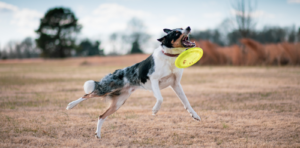If you’re anything like most busy professionals and active families, your calendar probably looks like a color-coded battlefield. Between work meetings, kids’ activities, travel plans, and trying to squeeze in some self-care, it’s easy for your dog’s training to slip down the list. You love your dog, of course you do, but finding time to train feels like just one more thing on a never-ending to-do list.
Here’s the truth: you don’t need hours each day to raise a well-behaved, confident dog. You just need the right approach, one that fits into your lifestyle, not the other way around.
One client notes, “I once struggled with this myself. When I brought home my young dog, I was already juggling a packed schedule. I’d tell myself, ‘I’ll train after dinner,’ but by the time I sat down, the only thing I wanted to lift was the TV remote. Eventually, I realized my system wasn’t working. So, I tried shorter, structured bursts of training woven throughout the day, five minutes here, two minutes there. Once I shifted my mindset, training became part of our daily rhythm instead of a separate chore. And you know what? It worked better than anything else I’d tried.”
Let’s dive into how you can do the same, and still make it to that 8 a.m. strategy call or your kid’s soccer game.
Why Busy Households Struggle with Dog Training
Families with demanding schedules often share the same challenge: time scarcity. You’ve built a full life, and success brings commitments, often a lot of them. But while you can outsource lawn care or grocery delivery, your dog’s behavior can’t just be handed off entirely.
Dogs crave consistency and connection. They learn through repetition and routine. If those things are missing, you’ll likely see frustration on both ends of the leash, barking, pulling, or ignoring commands. The good news? These issues aren’t a sign of failure. They’re just signals that your training needs to adapt to your lifestyle.
Shift Your Mindset: Training Is a Lifestyle, Not an Event
Most people think of dog training as something that happens during a set block of time, like going to the gym or attending a class. But the best trainers know that it’s not a one-hour event; it’s a lifestyle.
You don’t have to carve out half your weekend. Instead, start weaving training moments into what you’re already doing.
While brewing your morning coffee: Ask your dog to “sit” and “stay” before you pour. Reward with a treat or gentle praise.
During family dinner prep: Practice “place” while the kids set the table.
Before bedtime: Run through a short routine of commands, it helps your dog wind down, too.
These micro-moments add up quickly. Just 10–15 minutes a day, broken into small bursts, can completely transform your dog’s behavior over time.
Create a Daily Routine That Sticks
Busy professionals thrive on structure, calendars, schedules, reminders. So why not apply the same tools you use for work and family to your dog’s training?
Add training to your calendar.
Schedule short sessions the same way you would a meeting. Even if it’s just five minutes in the morning and five at night, block it out.Tie training to existing habits.
Habit-stacking is powerful. If you already walk your dog each morning, use the first five minutes to practice leash manners. If you feed at set times, add a “wait” command before setting the bowl down.Rotate responsibilities.
Make it a family project. Each person can be in charge of one small task, one person practices “come,” another works on “stay.” Not only does this lighten the load, but it also helps your dog listen to everyone, not just one handler.
Use Professional Support Wisely
Many working families turn to professional trainers, and that’s a great choice, as long as it’s part of an ongoing plan. Think of your trainer as your dog’s “coach” and your family as the team. You wouldn’t expect a coach to win games without player participation, right?
Look for programs that combine in-person coaching with at-home accountability. For example, Alaska Dog Works’ Peak Performance Membership and Lead Dog Service Dog Training Program are designed for exactly this kind of flexibility. You get structured sessions, online tools, and guidance to keep you on track between lessons.
When evaluating programs, ask:
Do they offer virtual check-ins or online modules?
Is the training personalized to your lifestyle?
Do they provide follow-up support or community access?
Professional help is worth every penny when it fits seamlessly into your busy life and builds long-term success instead of short-term obedience.
Make Training Part of Family Life
One of the biggest mistakes people make is treating dog training as a solo mission. But when you involve your entire household, training becomes easier, and more fun.
Turn it into a game: Use friendly competitions. Who can get the best “sit-stay”?
Celebrate milestones: Just like a kid’s report card, track your dog’s progress.
Include your dog in routines: Dogs love predictability. If they know what’s expected, they’ll start offering good behavior automatically.
Families who include their dogs in the everyday flow, carpool runs, park trips, even TV time, naturally reinforce training. The dog learns that good behavior equals access and connection, not isolation.
Tech and Tools That Save Time
Modern families love efficiency, and there are some great tools to make training easier to fit in:
Smart feeders and cameras: These help monitor feeding times and even allow remote reward delivery.
Clicker apps: You don’t have to carry extra gear. A quick “click” on your phone can mark good behavior instantly.
Training journals or habit trackers: Apps like Notion or simple notes on your phone can help you track daily progress in seconds.
These aren’t replacements for real engagement, but they’re excellent supplements when life gets busy.
Focus on Quality, Not Quantity
Five focused minutes beats 30 distracted ones every time. Dogs sense your energy. If you’re multitasking, they’ll pick up on it and lose focus, too.
When you train, even briefly, be fully present. Turn off notifications, put your phone down, and make it count. A single, positive interaction can build your dog’s confidence for the entire day.
Remember: dogs live in the moment. They don’t care how long it takes, they care that you show up.
Hire Help Without Guilt
Let’s be honest, time is your most valuable resource. So don’t feel guilty about hiring help when you need it. Whether that’s a trainer, dog walker, or a day-training program, outsourcing some of the heavy lifting can make your life smoother and your dog happier.
Look for local trainers who offer:
Pick-up and drop-off services
Structured day-training (not just daycare)
Weekly progress reports and at-home assignments
This hybrid approach gives your dog consistency while still keeping you part of the process. It’s like having a personal trainer, they handle the details, but you still reap the results.
Build a Calm, Connected Household
Dog training isn’t just about obedience, it’s about harmony. A well-trained dog makes home life calmer, travel easier, and relationships stronger. When your dog knows what’s expected, everyone relaxes.
Here’s what that looks like in practice:
No more wrestling the leash at 6 a.m.
No more barking battles during Zoom calls.
No more embarrassment when guests arrive.
Instead, you have a confident, well-mannered companion who fits beautifully into your busy lifestyle.
Real-World Example: The Two-Minute Rule
If there’s one strategy that’s been a game-changer for our clients, it’s the two-minute rule. Every time you interact with your dog, even briefly, spend two minutes reinforcing something good.
Coming in the door? Practice calm greetings.
Heading to the car? Ask for a sit and wait.
Feeding dinner? Add a “stay” before release.
That’s it. Two minutes. The repetition builds reliability, and before you know it, your dog’s training is rock-solid, without ever scheduling an extra hour.
Travel Days, Work Trips, and Other Realities
Let’s face it, many professionals and families travel frequently. Whether it’s business trips or family vacations, the challenge isn’t just keeping up with training; it’s maintaining consistency when routines change.
A few simple tips:
Pack a training kit: Treats, clicker, leash, and collapsible bowl, easy to carry.
Keep cues consistent: No matter where you are, the same words and expectations apply.
Use downtime: Airport layover? Quick “focus” drills. Hotel lobby? Practice “place” on a mat.
Training travels with you, and it actually keeps your dog grounded when everything else feels unfamiliar.
When Life Gets Chaotic, Keep It Simple
Even the best systems will fall apart sometimes. You’ll miss a session, skip a walk, or forget to follow through. That’s okay. Don’t let guilt derail you.
Go back to basics:
Reward calm behavior.
Keep commands short and consistent.
Re-establish your rhythm when things settle.
Your dog won’t hold it against you. Dogs are incredibly forgiving, they just want to get back to the good stuff: connection, consistency, and love.
The Big Picture: Training as an Investment
Here’s the mindset shift that changes everything: dog training isn’t another expense, it’s an investment in your family’s quality of life.
When your dog listens, life feels smoother. You can host friends, travel more easily, and feel proud of how your dog behaves in public. It’s not just about obedience; it’s about freedom.
For busy professionals and families, time is precious. The less you spend managing chaos, the more time you can spend enjoying your dog, hiking, traveling, relaxing. That’s the return on investment training provides.
Balancing a busy schedule with dog training doesn’t have to feel impossible. Once you see training as part of daily life, not a separate project, everything clicks into place.
You can have both: a full, successful life and a well-trained dog who fits seamlessly into it. Start small, stay consistent, and remember, progress beats perfection every time.
If you’re ready to bring structure and sanity back to your routine, consider a professional program designed for families like yours. At Alaska Dog Works, we specialize in helping active families and professionals build calm, confident, well-trained dogs through flexible programs that work with your lifestyle.
Because no matter how busy you are, there’s always time to build a better bond with your best friend.
We offer a FREE Strategy Call.
Click on the graphic to learn more
Read More


Apple iPad Air (10.5-inch, Wi-Fi, 64GB) – Space Gray (Latest Model)








